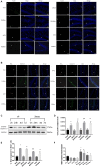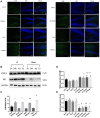Sevoflurane-Induced Neuroapoptosis in Rat Dentate Gyrus Is Activated by Autophagy Through NF-κB Signaling on the Late-Stage Progenitor Granule Cells
- PMID: 33384584
- PMCID: PMC7769878
- DOI: 10.3389/fncel.2020.590577
Sevoflurane-Induced Neuroapoptosis in Rat Dentate Gyrus Is Activated by Autophagy Through NF-κB Signaling on the Late-Stage Progenitor Granule Cells
Abstract
Objective: The mechanisms by which exposure of the late-stage progenitor cells to the anesthesia sevoflurane alters their differentiation are not known. We seek to query whether the effects of sevoflurane on late-stage progenitor cells might be regulated by apoptosis and/or autophagy.
Methods: To address the short-term impact of sevoflurane exposure on granule cell differentiation, we used 5-bromo-2-deoxyuridine (BrdU) to identify the labeled late-stage progenitor granule cells. Male or female rats were exposed to 3% sevoflurane for 4 h when the labeled granule cells were 2 weeks old. Differentiation of the BrdU-labeled granule cells was quantified 4 and 7 days after exposure by double immunofluorescence. The expression of apoptosis and autophagy in hippocampal dentate gyrus (DG) was determined by western blot and immunofluorescence. Western blot for the expression of NF-κB was used to evaluate the mechanism. Morris water maze (MWM) test was performed to detect cognitive function in the rats on postnatal 28-33 days.
Results: Exposure to sevoflurane decreased the differentiation of the BrdU-labeled late-stage progenitor granule cells, but increased the expression of caspase-3, autophagy, and phosphorylated-P65 in the hippocampus of juvenile rats and resulted in cognitive deficiency. These damaging effects of sevoflurane could be mitigated by inhibitors of autophagy, apoptosis, and NF-κB. The increased apoptosis could be alleviated by pretreatment with the autophagy inhibitor 3-MA, and the increased autophagy and apoptosis could be reduced by pretreatment with NF-κB inhibitor BAY 11-7085.
Conclusion: These findings suggest that a single, prolonged sevoflurane exposure could impair the differentiation of late-stage progenitor granule cells in hippocampal DG and cause cognitive deficits possibly via apoptosis activated by autophagy through NF-κB signaling. Our results do not preclude the possibility that the affected differentiation and functional deficits may be caused by depletion of the progenitors pool.
Keywords: NF-κB; apoptosis; autophagy; dentate gyrus; differentiation; sevoflurane.
Copyright © 2020 Tong, Ma, Su, Wang, Xu, Zhang, Wu, Liu and Zhao.
Conflict of interest statement
The authors declare that the research was conducted in the absence of any commercial or financial relationships that could be construed as a potential conflict of interest.
Figures











Similar articles
-
Defining the Vulnerability Window of Anesthesia-Induced Neuroapoptosis in Developing Dentate Gyrus Granule Cells - A Transgenic Approach Utilizing POMC-EGFP Mice.Neuroscience. 2019 Sep 1;415:59-69. doi: 10.1016/j.neuroscience.2019.07.009. Epub 2019 Jul 10. Neuroscience. 2019. PMID: 31301366
-
Repeated 2% sevoflurane administration in 7‑ and 60-day-old rats : Neurotoxicity and neurocognitive dysfunction.Anaesthesist. 2017 Nov;66(11):850-857. doi: 10.1007/s00101-017-0359-4. Epub 2017 Sep 15. Anaesthesist. 2017. PMID: 28914327 English.
-
NF-κB/P65 signaling pathway: a potential therapeutic target in postoperative cognitive dysfunction after sevoflurane anesthesia.Eur Rev Med Pharmacol Sci. 2017 Jan;21(2):394-407. Eur Rev Med Pharmacol Sci. 2017. PMID: 28165545
-
Perinatal supplementation with omega-3 polyunsaturated fatty acids improves sevoflurane-induced neurodegeneration and memory impairment in neonatal rats.PLoS One. 2013 Aug 13;8(8):e70645. doi: 10.1371/journal.pone.0070645. eCollection 2013. PLoS One. 2013. PMID: 23967080 Free PMC article.
-
Bumetanide attenuates sevoflurane-induced neuroapoptosis in the developing dentate gyrus and impaired behavior in the contextual fear discrimination learning test.Brain Behav. 2022 Nov;12(11):e2768. doi: 10.1002/brb3.2768. Epub 2022 Oct 2. Brain Behav. 2022. PMID: 36184814 Free PMC article.
Cited by
-
A protective role of autophagy in fine airborne particulate matter-induced apoptosis in LN-229 cells.Toxicology. 2022 Jul;477:153271. doi: 10.1016/j.tox.2022.153271. Epub 2022 Jul 22. Toxicology. 2022. PMID: 35872226 Free PMC article.
-
Efficacy of melatonin in alleviating disorders arising from repeated exposure to sevoflurane in males and females of the Wistar rats during preadolescence.Sci Rep. 2024 May 24;14(1):11889. doi: 10.1038/s41598-024-62170-4. Sci Rep. 2024. PMID: 38789558 Free PMC article.
-
SynCAM1 deficiency in the hippocampal parvalbumin interneurons contributes to sevoflurane-induced cognitive impairment in neonatal rats.CNS Neurosci Ther. 2024 Jan;30(1):e14554. doi: 10.1111/cns.14554. Epub 2023 Dec 17. CNS Neurosci Ther. 2024. PMID: 38105652 Free PMC article.
-
Subunit-specific mechanisms of isoflurane-induced acute tonic inhibition in dentate gyrus granule neuron.Exp Biol Med (Maywood). 2024 Oct 28;249:10171. doi: 10.3389/ebm.2024.10171. eCollection 2024. Exp Biol Med (Maywood). 2024. PMID: 39529664 Free PMC article.
-
Propofol and Sevoflurane Anesthesia in Early Childhood Do Not Influence Seizure Threshold in Adult Rats.Int J Environ Res Public Health. 2021 Nov 24;18(23):12367. doi: 10.3390/ijerph182312367. Int J Environ Res Public Health. 2021. PMID: 34886095 Free PMC article.
References
LinkOut - more resources
Full Text Sources
Research Materials

